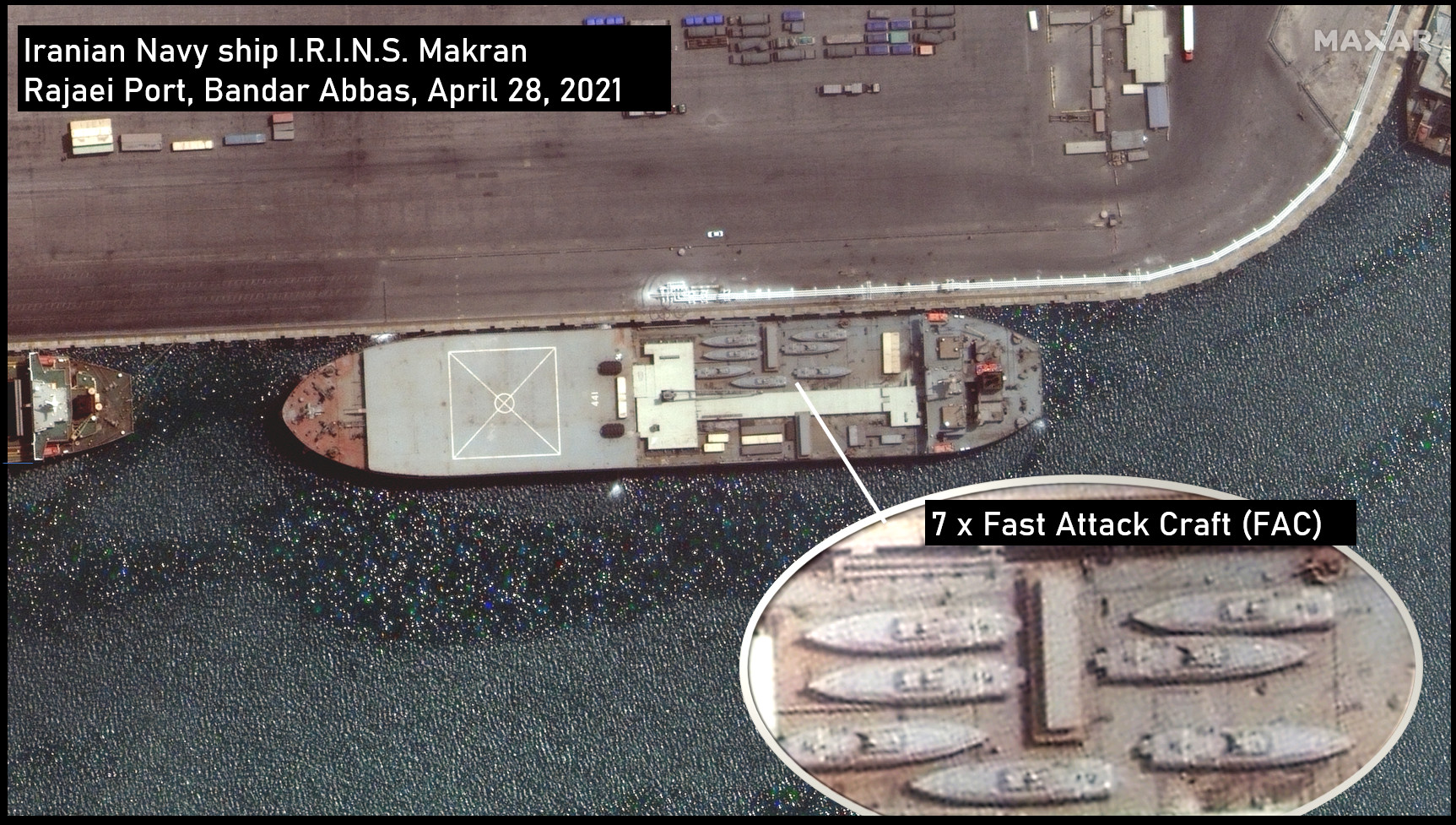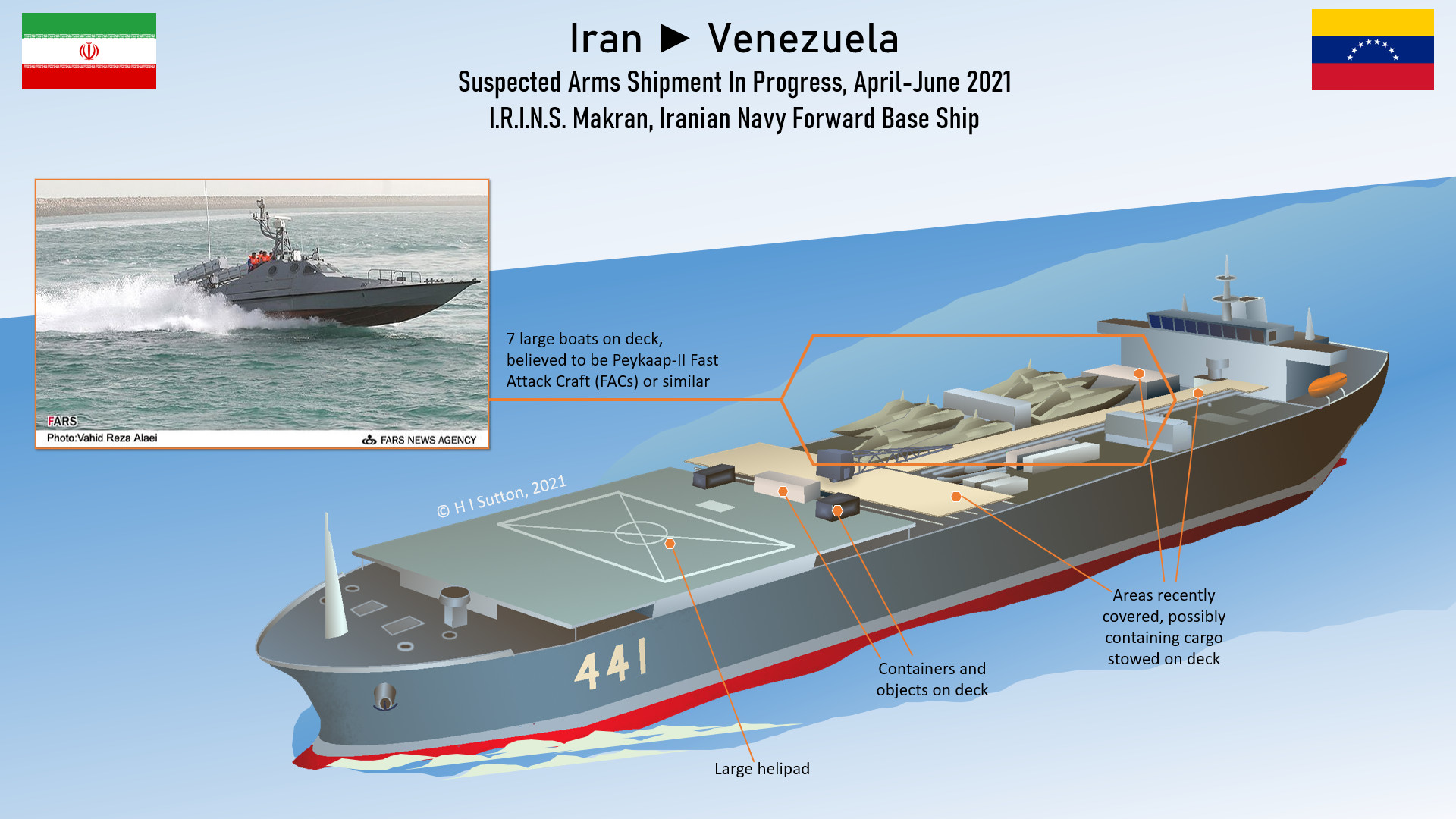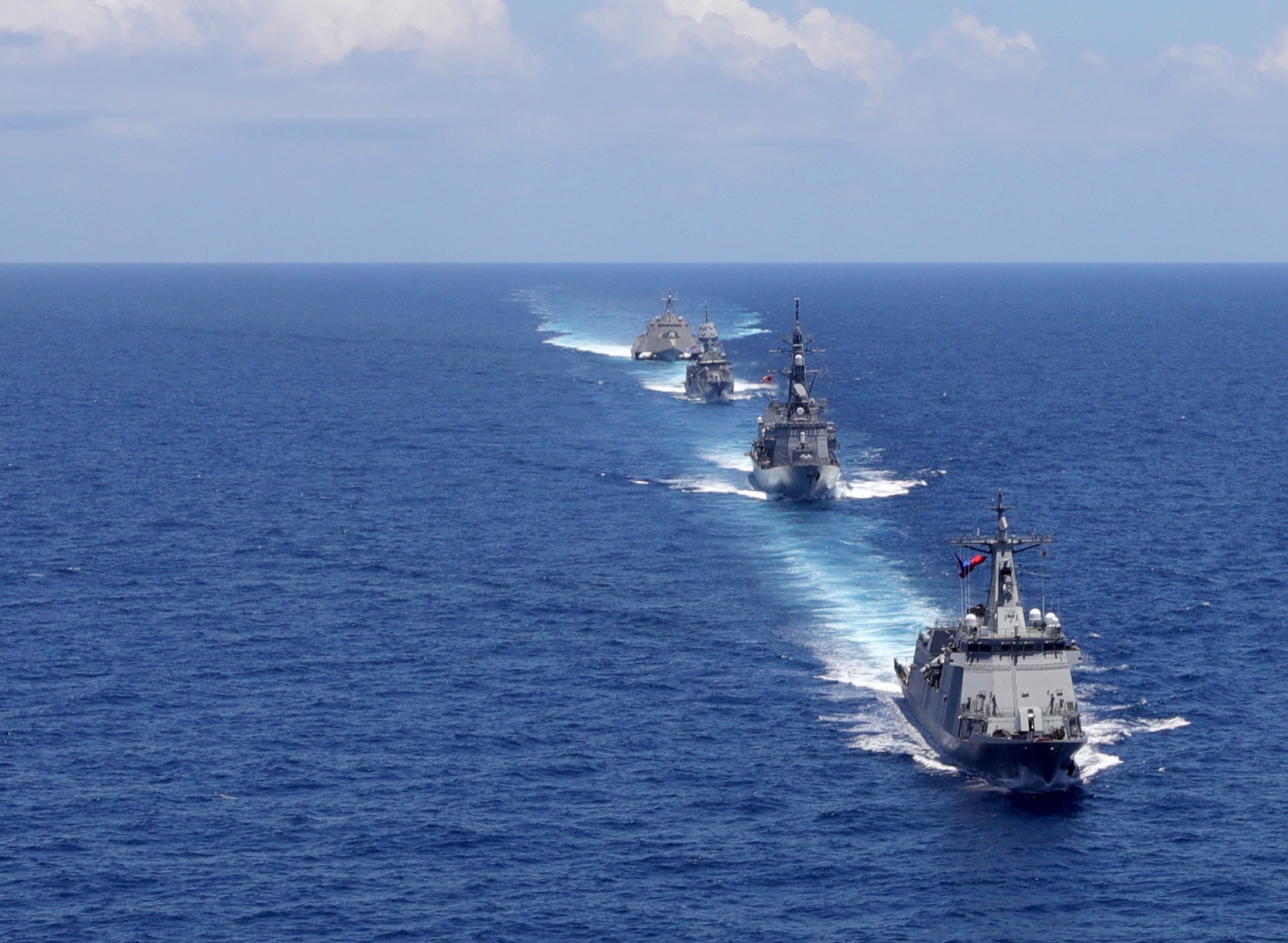
This post has been updated with a statement from the Pentagon and the Iranian Foreign Ministry.
An Iranian Navy ship thought to be bound for Venezuela left its port in late April with seven high-speed missile-attack craft strapped to its deck, USNI News has learned.
According to imagery provided to USNI News by Maxar, the Iranian Navy’s new forward-basing ship, IRINS Makran, was seen on April 28 after leaving its homeport with seven attack boats aboard.
Last week, citing three U.S. officials, Politico reported that the Pentagon believes Makran and an Iranian frigate were steaming down Africa’s east coast ultimately bound for Venezuela. On Monday, Iranian Foreign Ministry officials asserted their rights to operate worldwide when asked about Makran heading to Venezuela.
“[Mistry spokesman] Saeed Khatibzadeh emphasized Iran’s legal right to go through all international seas,” according to a summary of a Monday press conference from the state-controlled Iran Press News Agency.
“Khatibzadeh also warned the U.S. officials about any actions against Iranian ships.
Those boats seen in the satellite images match the characteristics of the Peykaap family of medium-sized fast attack craft (FAC) operated by the sectarian Islamic Revolutionary Guard Corps Navy (IRGCN). The IRGCN is responsible for the coastal security of Iran and the Strait of Hormuz and similar vessels equipped with torpedoes and missiles have been used to harass U.S. ships in the Persian Gulf.
The seven missile craft aboard Makran are each approximately 57 feet (17.5 meters) long and match the Peykaap family of medium-sized fast attack craft operated by Iran. There are several variations of these craft in Iranian service, although all are generally similar. The latest Peykaap-II type (also known as the Bavar class) is 57 feet long and can carry two anti-ship missiles and two 12.75 inch torpedoes. The missiles could be of the Kowsar or Nasr types, which are derived from Chinese models with a quite modest range of around 18 nautical miles.
Additionally, the ship could be carrying other military equipment not readily apparent from the imagery. A converted oil tanker, Makran is the Iranian Navy’s newest and largest warship. Its new role has been compared to the U.S. Navy’s Expeditionary Sea Base (ESB). Like the ESBs, the 755-foot long Makran is designed to be a mobile sea base for small boats and aircraft capable of operating anywhere around the world. The conversion added a large flight deck, the capacity to carry boats and other equipment on deck and additional cargo below.
There has been concern that Venezuela may attempt to acquire ballistic missile technology from Iran. Some areas of the deck are now covered, so it has not been possible to assess the full cargo of the ship. Venezuela’s regime, led by President Nicola Maduro, has talked openly about acquiring arms from Iran. Meanwhile, Iranian special forces belonging to the IRGC’s Quds force may already be assisting the Venezuelan military.
If the boats are delivered, they may form the core of an asymmetrical warfare force within Venezuela’s armed forces. This could be focused on disrupting shipping as a means of countering superior naval forces. Shipping routes to and from the Panama Canal are near the Venezuelan coast.

The Venezuelan Navy has tried over the last several years to beef up its own coastal defense ships with the acquisition of high-speed attack craft to enforce its territorial claims over the Caribbean Sea, according to an October entry in Jane’s World Navies.
Messages left with spokespeople in U.S. Southern and Central commands on Tuesday were not immediately returned.
Pentagon spokesman John Kirby would not confirm the move of Makran or the cargo when asked by USNI News on Tuesday.
“The Southern Command certainly has the ability to look after our interests in that part of the world,” he told reporters.
The deployment of Makran comes as Iran and Venezuela are growing closer together. Both governments are under sanctions from the U.S. government and have been restricted from accessing the global market.
Last year, the Maduro government exchanged nine tons of gold for assistance improving their petroleum refineries, reported Bloomberg. Iran has also shipped oil to Venezuela.
While it’s unclear if the craft seen on aboard Makran are meant for the Venezuelan Navy as part of ongoing arms sales or if the Iranians will drill with Venezuela’s own green water forces, the presence of the boats and U.S. officials’ belief that the Iranian ship is headed for South America suggest increasing military cooperation between Caracas and Tehran.
“The IRGC began working with the Venezuelan military in the early 2000s, and the two sides have continued to have a murky security relationship ever since. That relationship grew stronger in response to the external pressure aimed at toppling Maduro. With few friends, Maduro has leaned into his relationship with Iran and the IRGC is seeking to capitalize on the situation. Iran has managed to develop a number of military weapons and systems that could be useful for smaller states. It’s unsurprising that Venezuela might seek to procure some.” Iran expert Afshon Ostovar, a professor in the Department of National Security Affairs at the Naval Postgraduate School and author of Vanguard of the Imam: Religion, Politics, and Iran’s Revolutionary Guards, told USNI News on Tuesday.
“Selling FACs to the Venezuelans makes sense. Iran manufactured and outfits them. They’re useful in a variety of ways and difficult to counter in swarms. Iran can’t sell to many, but Venezuela is in that small category of potential buyers… This was just a matter of time, really.”
In March, U.S. Southern Command commander Adm. Craig Faller warned the Senate that the two countries have continued to expand cooperation to trade military resources.
“In the past year, Iran has expanded economic and security cooperation with Venezuela on fuel transfers, food staples, and military assistance, possibly expanding the Quds Force’s presence in the region,” Faller said in a statement to the Senate Armed Services Committee.
“Tehran also relies on a system of Iranian state-sponsored and non-state facilitated media outlets to shape the information domain to generate empathy for Iran and Shia Islam and diminish Western influence in the hemisphere.”





